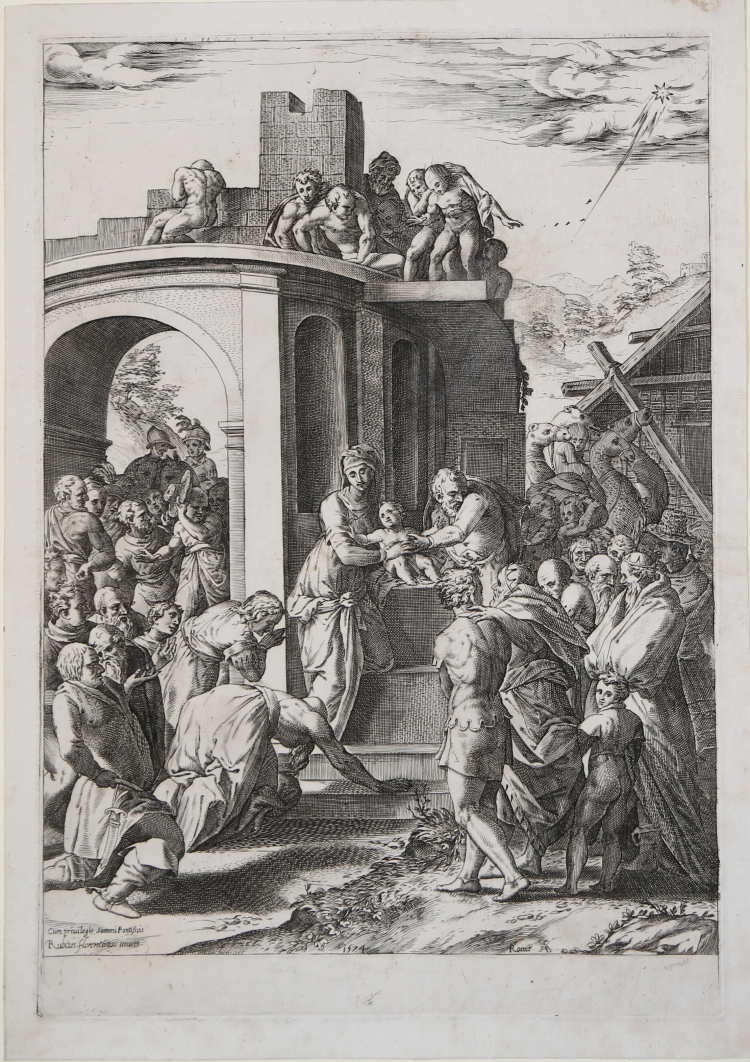



| Reference: | S32005 |
| Author | Cherubino ALBERTI |
| Year: | 1574 |
| Measures: | 265 x 362 mm |


| Reference: | S32005 |
| Author | Cherubino ALBERTI |
| Year: | 1574 |
| Measures: | 265 x 362 mm |
Engraving, lettered at bottom centre '1574' and to right with Alberti's monogram 'cAB'.
After Rosso Fiorentino.
Second state, inscribed “Cum privilegio summi Pontificis/Rubeus florentinus inven” in the area of the image at the lower left.
A very good impression, printed on contemporary laid paper, with margins, trace of central fold, generally in very good condition.
Vasari reported in his life of Rosso Fiorentino that after the Sack of Rome, the artist fled to Perugia where painter Domenico Alfani cared him, and that Rosso made for him a cartoon depicting the Adoration of the Magi.
The cartoon was then used by Domenico to paint the altarpiece for the church of Madonna dei Miracoli in Castel Rigone. After his death, the model likely passed to the Domenico’s son , Horace. Subsequently, the design now lost, was either acquired or borrowed by Cherubino Alberti who engraved it, in Rome in 1575.
The print is in reverse from the altarpiece and hence also from Rosso’s career. Compared to the painting, the dramatic fervor is more evident in Alberti’s print, which more accurately preserve Rosso’s design.
The Adoration of the Magi is one of the most remarkable and accurate planned invention of Rosso’s career. The crowding of figures, at the right and left, and the use of a large architectural setting, recalls the Battle of the Romans and the Sabines, while the spaciouness of the scene recalls othe San Rocco distributing his inheritance. However, the space in the Adoration of the Magi is far more ample than in either of other compositions, and the figures are placed more continuously in it.
The Child is held by the Virgin and St. Joseph and is sitting on a block of stone that is set amid ruins, not far from a newer wooden building, symbolic of the Old and New Testaments. The child’s position as though on an altar gives to the scene a sacramental quality. His outstretched arms suggests his eventual crucifixion.
|
Bartsch XVII.54.12; Carroll, p. 144 n. 48.
|
Cherubino ALBERTI Borgo San Sepolcro 1553 - Roma 1615
|
Engraver, painter and constructor of crossbows, from Borgo San Sepolcro. Active in San Sepolcro
and Rome. Record of death 18 October 1615.
The earliest dated engravings are of 1571.The bulk of his engraved work was produced between 1571 and 1590. Mythological,devotional and ornamental subject ;portraits and antiquities. Prints after Raphael,Michelangelo,Polidoro da Caravaggio,Andrea del Sarto, Rosso Fiorentino, Taddeo and Federico Zuccaro. He kept control of the majorityof his plates and was responsible for publishing them. After his death his heirs reissued many of them, with a privilege of Pope Urban VIII.
|
|
Bartsch XVII.54.12; Carroll, p. 144 n. 48.
|
Cherubino ALBERTI Borgo San Sepolcro 1553 - Roma 1615
|
Engraver, painter and constructor of crossbows, from Borgo San Sepolcro. Active in San Sepolcro
and Rome. Record of death 18 October 1615.
The earliest dated engravings are of 1571.The bulk of his engraved work was produced between 1571 and 1590. Mythological,devotional and ornamental subject ;portraits and antiquities. Prints after Raphael,Michelangelo,Polidoro da Caravaggio,Andrea del Sarto, Rosso Fiorentino, Taddeo and Federico Zuccaro. He kept control of the majorityof his plates and was responsible for publishing them. After his death his heirs reissued many of them, with a privilege of Pope Urban VIII.
|